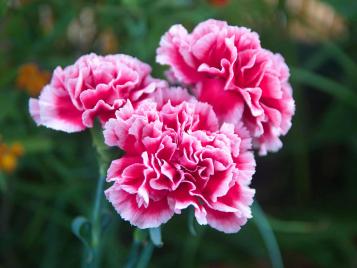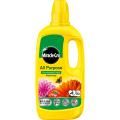

How to grow Dianthus
Dianthus spp. is the collective name for over 300 species of fragrant frilly-edged flowers. You may have heard of ‘Carnations’, ‘Sweet Williams’, and ‘Pinks’ - these are all types of Dianthus. In this article we will look at annual, perennial and biennial types, and how to easily look after these fast-growing, attractive plants.
Types of Dianthus to grow
Most species of Dianthus only reach 60cm (24") high at the most. They all have pleasant blue-green stems and foliage, and five petalled flowers.
Annual Dianthus grow and die in the same year. This means that they have to be re-sown or replaced with new plants each growing season. Dianthus chinensis, also known as China pink or rainbow pink, is usually grown as an annual bedding plant in the UK. We particularly like:
- Dianthus chinensis ‘Zebra Crossing’, with very dark purple flowers and white edging.
- Dianthus chinensis 'Coronet Mixed’, a mix of solid and bi-coloured flowers featuring shades of pink, red, purple and white.
Perennial Dianthus are the longest lived of the three types, coming back every year. They will thrive until they are about six years old. At this point they can become very woody and lose their attractiveness, so are best replaced. We really like:
- Dianthus deltoides. Sometimes called a maiden pink. Narrow leaves and a pink flower.
- Dianthus plumarius. Also known as pinks and clove pinks, this species is a highly scented species with a range of differently coloured flowers.
- Dianthus carophyllus. Commonly called carnations, and occasionally clove pink. This species is taller than most other Dianthus, reaching 80cm (32") high.
- Dianthus knappii. A yellow-flowering variety with slightly hairy stalks.
Biennial Dianthus put on lots of growth in their first year, but don’t bloom until their second year, after which they die. The most common biennial Dianthus is the Sweet William, which is a prolific seed spreader, meaning that if allowed, the plant will grow, flower, set seed and then grow from those self-spread seeds. We recommend trying:
- Dianthus barbatus ‘Festival Mixed’. A mix of solid pink colours, with some bi-colour flowers featuring whites and reds.
- Dianthus barbatus ‘Rockin’ Red’. Deep green foliage and solid, dark red coloured flowers.

What you’ll need to grow Dianthus
Always wear gloves when handling plants and compost.
For Dianthus grown from seed:
- Seed tray.
- Compost.
- Watering can with fine rose.
- Propagator (for early sowings, not necessary for those sown in the summer).
- Dianthus seeds.
For Dianthus grown from purchased plants:
- Garden spade (only for those being planted in the ground).
- Container (only for those being grown in pots).
- Watering can.
- Dianthus plants.
- Compost.
- Fertiliser.
- Fertiliser (only for those being grown in pots).
Where to plant Dianthus
Given their relatively low growing height, Dianthus look good at the front of a border. They also grow well in pots and do not mind slightly dry conditions, which containers often have. They like well-drained soil and need at least six hours of sunlight each day, so choose a sunny spot. Dianthus are poisonous to cats and dogs, so plant them out of reach of pets.
When to plant Dianthus
Sow annual seeds under protection from February onwards, and directly outdoors from April through to July. Earlier sown seeds of biennial and perennial types have a better chance of flowering the same year if they are sown in the spring, but will need gentle heat from a propagator to start them off.
Plants can be moved outside once the chance of frost has passed, typically from May onwards.
How to sow Dianthus
- If sowing indoors for an earlier crop, fill the seed tray with compost. If sowing outdoors, prepare the soil by clearing it of any weeds and large stones.
- Using a fine-rosed watering can, wet the compost or soil.
- Sow seeds on the surface of the compost or soil.
For indoor sown seeds:
- Move the seed tray to a protected environment such as a propagator, to maintain a consistent temperature.
- Water regularly and once there is no risk of frost, usually from May through to October, prepare to transplant to their final positions in a container or the ground.
- Allow 30cm (1') between each plant, so that air can circulate freely around them. Using the garden spade, dig a hole in the ground slightly larger than the rootball of the plant. Fill the hole with water and allow to drain away. Add a spadeful of compost to the hole, and for container-grown Dianthus, loosely fill the pot with the same compost.
- Place the rootball of the plant in the hole or container, so that the top of it is 2cm (1”) below the surface of the soil, or rim of the container.
- Backfill the soil and firm in to ensure good contact with the roots; for those in containers, add more compost and firm to achieve the same effect.
For outdoor sown seeds:
- Once germinated, thin plants to 30cm (1') between each plant.
- Keep well watered.
Perennial Dianthus can also be propagated very easily by stem cuttings. Follow the steps in our handy guide, and once ready for transplanting, treat as above.
Caring and nurturing for Dianthus
Light: Dianthus need at least six hours of good sunlight each day. Either plant in a border where they will receive this, or move pots around as needed to ensure they get the required amount of sunlight.
Soil
Dianthus prefer well-drained soil which is neutral to slightly alkaline.
Water
Water well in dry periods, although they will tolerate dry conditions well.
Fertiliser
Feed perennial types in late spring with Miracle-Gro® Premium All Purpose Continuous Release Plant Food Tablets. Give container grown plants a monthly feed with Miracle-Gro® Drip & Feed All Purpose.
Pruning
Deadhead flowers that are past their best to encourage fresh flowering. In the winter, frosts will make the foliage of perennial types look a little bit brown and scraggy. Cut back to within 2-3cm (1") of the ground, and mulch with Miracle-Gro® Peat Free Premium Border Booster Soil Improver.
Propagation
Keep an ever-ready group of new perennial Dianthus ready to plant out to replace others, by propagating existing plants. Take stem cuttings in the summer from healthy Dianthus. Select a non-flowering shoot, holding it just below a leaf node, and pull the rest of the stem with the other hand. It will break off easily - remove the lower leaves, and insert into a small pot of compost, from which it will soon put on new growth.
Common pests and diseases with Dianthus
Slugs and snails
Slugs and snails love eating the fresh young foliage of Dianthus. Look out for shiny, slime trails, and remove by hand. Prevent and control populations with our tips for managing slugs and snails.
Rust
Orange coloured patches appear on Dianthus plant foliage. Remove and destroy affected parts of the plant, and see our guide to rust treatment and prevention.
Wilt
Parts of the Dianthus plant suddenly wilt, with no obvious water-related cause. Cut off and destroy the parts of the plant that are affected, and see our guide to wilts to identify the cause and correct treatment.
Aphids
Clusters of small bugs enjoy eating the tips of Dianthus plants. Squish them by hand or blast off with water. If problems persist, visit our guide to dealing with aphids.
Dianthus rot
Dianthus are susceptible to water-related problems, and will quickly react to overly moist conditions. Avoid planting in water-logged soils and don’t allow container grown Dianthus to sit in water. Add horticultural grit to compost if there is a known problem with water-logging, to encourage better drainage.
Frequently asked questions about Dianthus
Are Dianthus invasive?
No, Dianthus do not generally spread. Dianthus barbatus will self-seed willingly, however these are easily removed if not wanted.
Can Dianthus be grown as a house plant?
Dianthus prefer to grow outdoors, but make lovely cut flowers which can then be brought inside for a long-lasting display.
Are Dianthus a good flower for a cottage garden?
Absolutely, yes. Dianthus plants produce flowers which are well suited to a traditional garden, and they look great planted amongst foxgloves and Love-in-the-mist.
Are Dianthus poisonous?
Dianthus are poisonous to cats and dogs. Humans can eat the petals, and they look great added to a garden salad. Pet rabbits are not usually affected, and neither (unfortunately) are slugs and snails!
Key features of Dianthus
| Botanical Name | Dianthus |
|---|---|
| Plant Type | Annual, biennial or perennial |
| Family | Caryophyllaceae |
| Light Exposure | Full sun |
| Soil pH | Neutral to alkaline |
| Flowering Time | April to September |
| Flower Colour | Pink, occasionally purple, red, white or yellow |




